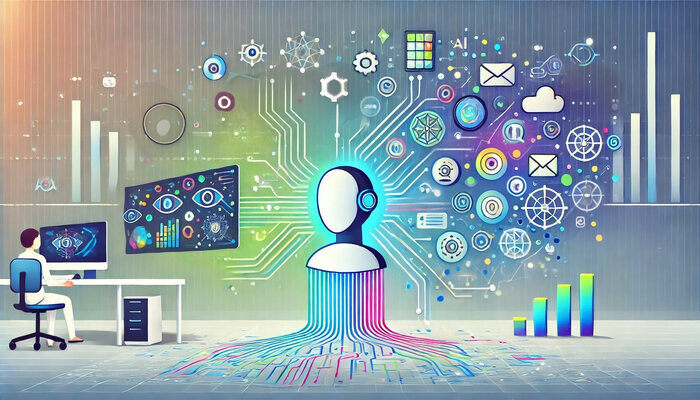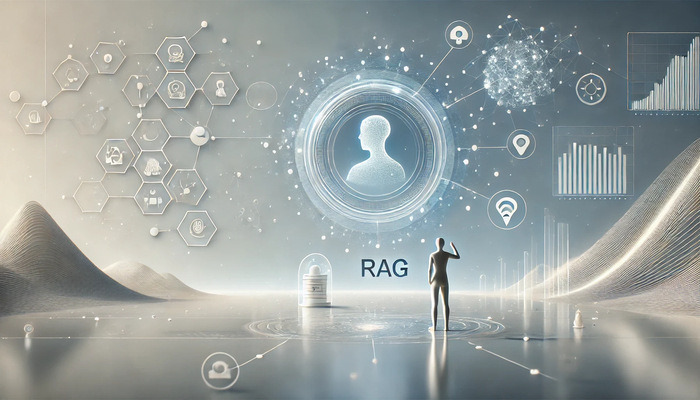
With a wide range of innovations in the field of Artificial Intelligence, a new buzzword has cropped up: RAG, also known as Retrieval-Augmented Generation. This innovative concept holds great potential for changing how we interact with AI systems in the future by making them more intelligent, efficient, and effective.
For instance, think of a virtual customer support agent that not only understands your inquiry but also provides accurate and timely information related to a specific product, its features, and its availability. This is made possible through RAG, which allows the agent to retrieve relevant information from a vast knowledge base and come up with a response that is both informative and personalized. With RAG, AI systems can now respond with more specific and appropriate answers, making them a must-have tool in fields ranging from healthcare to finance.
What Is RAG?
This concept is groundbreaking because it combines the strengths of two distinct AI technologies: Retrieval and Generation. Traditionally, these two functions are separate in a typical AI system: Retrieval focuses on extracting relevant information from an incoming knowledge base, while Generation creates new content based on the retrieved information. The integration of these processes enables AI systems to retrieve relevant information and simultaneously generate new, contextually accurate content.
This integration significantly enhances the performance and precision of AI systems. For instance, a healthcare chatbot can retrieve a patient’s medical history and generate personalized treatment plans informed by the latest medical research and guidelines. Similarly, in e-commerce, a product recommendation system can retrieve details about a customer’s purchase history and generate tailored product suggestions, boosting sales and customer satisfaction.
By combining Retrieval and Generation, this integrated approach allows AI systems to deliver results that are more precise, relevant, and personalized. This makes RAG an indispensable tool in many fields of human endeavor. It holds enormous potential to transform how we interact with AI systems.
Retrieval-Augmented Generation: What Is It Used For?
The main goal of RAG is to increase the speed and accuracy of AI applications – ranging from language models and chatbots to question-answering systems – by leveraging the power of retrieval and generation. With this approach, AI systems will be able to:
- Gain relevant information: Through advanced retrieval techniques, AI can quickly and accurately extract relevant information from large knowledge bases, ensuring the generated content is timely and pertinent.
- Create high-value content: Combining retrieved data with generative capabilities enables AI to produce context-specific, high-value content that is more accurate and detailed.
- Ensure consistency in knowledge: By leveraging retrieval and generation together, AI can maintain consistency within datasets, minimizing contradictions and inaccuracies.
- Improve user experience: Delivering precise and relevant information enhances user experiences in applications such as customer support, language translation, and content creation.
In the following section, you will learn about the benefits and applications of RAG in great detail to see how this technology will ensure that a smarter generation of AI systems is realized.
Unlocking the Power of RAG: Key Benefits
This integration has wide-reaching implications for the development of AI systems. RAG combines these technologies to enable AI systems to provide responses that are more accurate, relevant, and personalized, making them indispensable tools in various fields.
Increased Precision and Relevance
One of the major advantages of RAGis its ability to deliver more precise and relevant answers. By allowing an AI system powered by RAG to retrieve information relevant to a specific question from a vast knowledge base while simultaneously generating new content, it reduces the likelihood of errors and inaccuracies. This is particularly important in industries that have direct implications for human lives, such as healthcare, as well as other critical sectors like finance and law.
Increased Personalization
RAG enables AI systems to generate more personalized responses by considering user preferences, needs, and context. A RAG-powered virtual assistant, for instance, could retrieve a user’s search history to generate personal recommendations, increasing the likelihood of a sale. A RAG-based chatbot may retrieve the purchase history of a customer and generate personal offers, enhancing customer satisfaction.
Increased Efficiency
Another powerful benefit of RAG is its potential to increase efficiency across many industries. With RAG-driven AI systems automating the process of information retrieval and content generation, the time and effort required to complete tasks would be reduced. This would, in turn, free up human resources for more complex and creative tasks.
Applications of Retrieval-Augmented Generation
The applications of RAG are numerous and diverse, with several sectors where it can be applied to:
- Healthcare: RAG-powered chatbots can retrieve patient information and generate personalized treatment plans, leading to improved healthcare outcomes and reduced costs.
- E-commerce: Product recommendation systems powered by RAG retrieve customer data and generate tailored product suggestions, driving sales and improving customer satisfaction.
- Education: RAG-driven virtual learning assistants retrieve student information and develop personalized learning plans, improving student outcomes and reducing teacher workload.
- Customer Service: By retrieving customer information and generating personalized responses, RAG-powered chatbots enhance customer satisfaction while simultaneously reducing support costs.
Next, we will delve into the technical aspects of RAG: its architecture and implementation, as well as its challenges and limitations of, and how these are being addressed by researchers and developers.
Technical Aspects of RAG: Architecture and Implementation
The architecture of RAG is designed in such a way that strong retrieval, combined with generation, ensures the AI system’s ability to retrieve relevant information and generate new content simultaneously. The three major components of the architecture are as follows:
- Retrieval Module. This module is responsible for extracting relevant information from large knowledge bases. It uses various retrieval algorithms, ranging from keyword extraction to semantic search.
- Generation Module. This module generates new content using the retrieved information. It employs several types of generation algorithms, such as language models and sequence-to-sequence models, to enhance output quality.
- Integration Module. This module combines the retrieved information with the generated content, ensuring that the final output is accurate, relevant, and personalized.
The key steps in the implementation of RAG are as follows:
- Data Preparation. The knowledge base is created by collecting and processing large amounts of data from various sources.
- Model Training. Various machine learning algorithms and techniques are tested to train the Retrieval and Generation models using the prepared data.
- Integration and Testing. This involves the development of the Integration Module and testing for accuracy, relevance, and personalization of the output.
This approach requires careful data preparation, model training, and integration and testing. In fact, the more we understand the technical aspects behind RAG, the better we can unlock its full potential and apply it for transformative innovations in the field of AI.

Challenges and Limitations of RAG
Though RAG holds promising potential in the world of AI, there are several challenges and limitations associated with its use. Among the main challenges are:
- Data Quality. This is closely related to the quality of the knowledge base, which ensures the relevance and accuracy of the output. For example, poor data quality can lead to irrelevant or incorrect responses.
- Model Bias. Both the Retrieval and Generation models could be biased, resulting in biased or discriminatory responses.
- Scalability. RAG is computationally expensive and somewhat challenging to scale.
These challenges are being addressed in the following ways by researchers and developers:
- New Algorithmic Development and Techniques. A variety of new algorithms and techniques are being developed to enhance precision and relevance in RAG.
- Data Quality Improvement. Efforts to improve the quality of the knowledge base are underway, with data cleaning and preprocessing being key components of this process.
- Model Bias Mitigation. Researchers are working to address model bias, including the development of techniques for detecting and mitigating bias.
Although RAG has enormous potential to break new ground in AI, these challenges must be addressed. Key challenges, including knowledge base quality, model bias, and scalability, require attention. Researchers and developers are actively working to overcome these challenges through the development of new algorithms, improvements in data quality, and bias mitigation techniques. By acknowledging and addressing these challenges, RAG can be developed and used responsibly and effectively.
The Future of RAG
The applications that can be achieved using RAG are endless. Capable of retrieving information and generating new content simultaneously, RAG has the potential to revolutionize many industries, including:
- Customer Service. RAG can be leveraged for chatbot and virtual assistant development providing accurate, personalized responses to customer inquiries.
- Content Creation. RAG will be useful in creating high-value content, such as articles, blog posts, and social media updates, by freeing up human time for more creative tasks.
- Education. RAG can be used to build personalized learning systems that offer customized learning materials and feedback to students.
Beyond being used in a wide array of domains, RAG is poised to play a significant role in the future of AI. By merging the strengths of Retrieval and Generation, RAG will help advance AI systems, supporting their continuous evolution and the development of more sophisticated AI models.
Potential Breakthroughs
Several ways are currently under research and development to further enhance the use of RAG, including:
- Multimodal Interaction. Designing RAG systems capable of interacting with users through various modalities, such as text, speech, and vision.
- Explainability. Building RAG systems that are transparent and explainable in their results, enabling users to understand how the system arrived at a particular response.
- Human-AI Collaboration. Creating RAG systems that can collaborate with humans in real time, facilitating better and quicker decision-making.
By continuing to push the boundaries of RAG’s possibilities, we can unlock its full potential and contribute to a future where AI systems are more advanced, personalized, and integral to our daily lives.

Conclusion
The integration of Retrieval and Generation in RAG has the potential to revolutionize the field of AI, enabling the development of more advanced, personalized, and effective AI systems. RAG can significantly improve the quality of answers, making them more informative and relevant, by combining the strengths of retrieval and generation. As we continue to push the limits of what is possible with RAG, we may be able to overcome some of the persistent challenges related to multimodal interaction, explainability, and human-AI collaboration. The future of RAG is bright, and its potential to revolutionize industries and improve our lives is both exciting and immense.
Good luck with your technical writing!
Author, host, and deliver documentation across platforms and devices.
